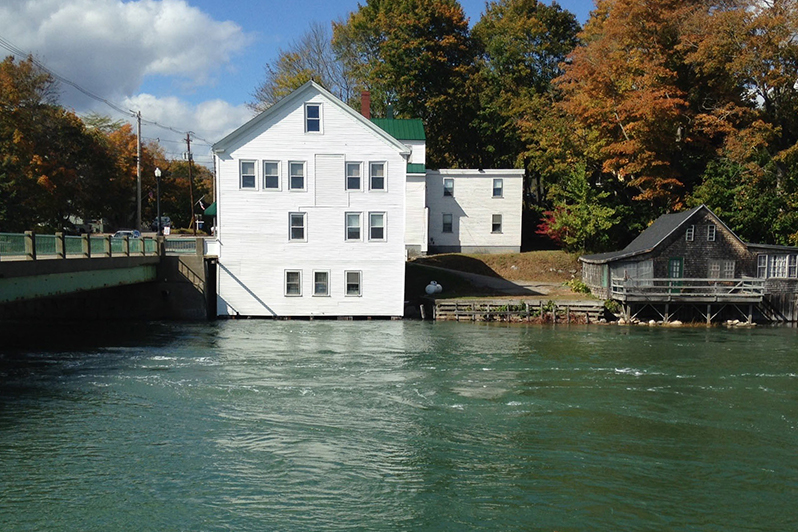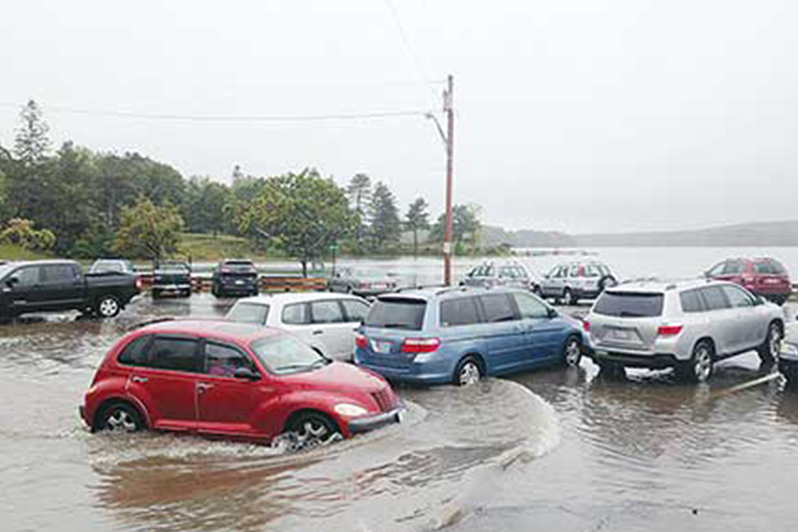BACKGROUND
At the gateway of the Pemaquid peninsula in Lincoln County is the historic coastal village of Damariscotta. Overlooking a tidal river, Damariscotta, with a population of around 2,200, was once inhabited by Native Americans drawn to the area, like many are today, for its oysters.
A famous shipbuilding port in the 1800s that connected the region to the world, Damariscotta still retains its importance as the peninsula’s year-round commercial and service center. The town’s downtown, bordered by the Damariscotta River, is home to numerous shops, art and culture establishments, restaurants, service providers and boating and fishing operations, attracting locals and tourists alike.
A coastal hazard study of Lincoln County, conducted in 2012 by the Lincoln County Regional Planning Commission and the Maine Geological Survey, set the town’s select board back on its heels when they saw visuals showing most of the downtown area under water at both one- and three-feet estimates of sea level rise. The study’s assessment concluded that the town’s downtown is particularly vulnerable to flooding due to sea level rise and storm surge because it is both low-lying and close to the river.
The community swung into action immediately, forming committees to examine and begin addressing the issue. Various projects are underway with more to come.
Q & A WITH MATT LUTKUS, DAMARISCOTTA TOWN MANAGER
What have been Damariscotta’s first steps?
We had the Milone & MacBroom Flood Resiliency Study completed in 2015. We accomplished the study through a Maine Coastal Resiliency Grant. The study gave us flood adaption options for the downtown and some cost estimates. The preferred recommendation is to build a sea wall along the municipal parking lot along the riverfront and raise the level of that parking lot as well as making some drainage, pedestrian and other improvements, such as the addition of a public restroom facility and enhancing the park that borders the harbor.
At this point, we don’t have a specific plan for implementing the recommendations with the exception of a few things because of the lack of serious interest on the part of the federal agencies who would be able to fund such projects. They’re focused on places like the Carolinas where the situation is dire.
The cost of the recommended flood resiliency project was in the neighborhood of $1.4 million. We’re a small town with a $6 million budget. $1.4 million seems like small change to some of the larger communities, but that’s a huge amount for us, so we would need to have some federal assistance to do that.
But, you’ve obviously been able to raise some funds to get some work done – you’ve improved the harborside park and plan on starting building of the public restroom. So, how did you get the funds?
We came up with the idea of rather than trying to look for a million-and-a-half dollars to get the whole waterfront project done, we’d split it up into doable segments. I started asking for funds in the capital improvement plan. This is where the private donors came it. They thought breaking up the whole into doable projects was sensible. Almost immediately we got $50,000 in private donations to redo the park. It was a realization that the town staff can get something done and they’ve got a reasonable plan to do it. We got $50,000 and we redid the park totally. It’s a beautiful green space now.
Then I got $11,000 in the public restroom account in capital reserves. It was next to nothing compared to the overall cost of the project, but it was a seed and it got it as a line item in our capital reserves.
When we did a bond issue for major sidewalk and culvert replacement, I added in $60,000 to it, then we had $71,000 for the restroom. This got the attention of some private donors and the Twin Villages Alliance who agreed to give us the money to get the project done. We have 12 to 16 donors for the project. We’ve acquired the site and torn down a dilapidated building and now we are putting together a request for proposal for the restroom structure.
There’s nothing in local or state statute that prohibits me from soliciting donations, but it’s awkward. I work with a member of the Twin Villages Alliance. He takes the lead in finding people to approach and I do the dog-and-pony show to those people. That’s worked out very well.
Getting donations has been like a snowball in a very positive way. Some of the folks who have seen the progress we’re making are saying, “OK, now you need to get this parking lot done, and you need to make the pedestrian improvements identified in the study and the drainage work which contributes to flood problems and we’re going to give you the money to do that.” It’s not enough money to do the whole thing, so my plan is to work with the sanitary district and whatever grants we can get our hands on, but we have two-thirds of the money committed by private donors.
The other thing we try to do is leverage the money we have. For example, we got $200,000 donated for sidewalk improvements around town. We took that $200,000 and leveraged it into $1.2 million by accessing funding from a variety of sources.
We’re trying to do that with the flood resiliency project. We’re taking the million dollars we’ve raised for the parking lot improvements that we’ll be doing next year and the year after and leveraging it to other sources. I’ve been talking to the water and sanitary district and I know the state has some clean water revolving funds for drainage improvements. I’m hoping we can use that money for the drains in the parking lot.
How have you communicated to the community the need for flood resiliency and what you’ve been doing to protect the downtown?
We’ve had community meetings and open houses and PowerPoint presentations. I’ve taken the PowerPoint presentation on the road, too. And we got a grant from the Orton Family Foundation for community outreach. We used the grant to survey residents and businesses about the various aspects of the waterfront project.
From the very start we had tremendous community support for flood protection and resiliency efforts. It was a no brainer to do something.
And the support – donors for instance – don’t just live in Damariscotta. They live in New Harbor, Newcastle, Pemaquid – throughout the peninsula – but they think of themselves as being from Damariscotta because the town is the designated service center for the area and people love the downtown. The reason many people live here is because of the downtown.
The theories of dealing with storm surge and sea level rise are to retreat or protect what you have. When Damariscotta’s downtown is gone, it’s gone. There’s no moving it to the high country. It’s not going to have the appeal for tourists or for residents if we build a new downtown up on the hill, so what we have to do is build that resiliency in to keep what we have.
RESOURCES
- Island Institute’s Sea Level Rise Symposium Presentations
- Damariscotta’s Waterfront Project materials
- Maine Flood Resilience Checklist
- Maine Coastal Program Shore and Harbor Planning Grants
- Lincoln County Regional Planning Commission
- Orton Family Foundation
- Island Journal 2019, Coalition Building at the Water’s Edge
- Island Journal 2019, Resilience is the Response to Rising Waters
- Island Journal 2019, Whelmed in Key Largo
Originally Published June 2019



